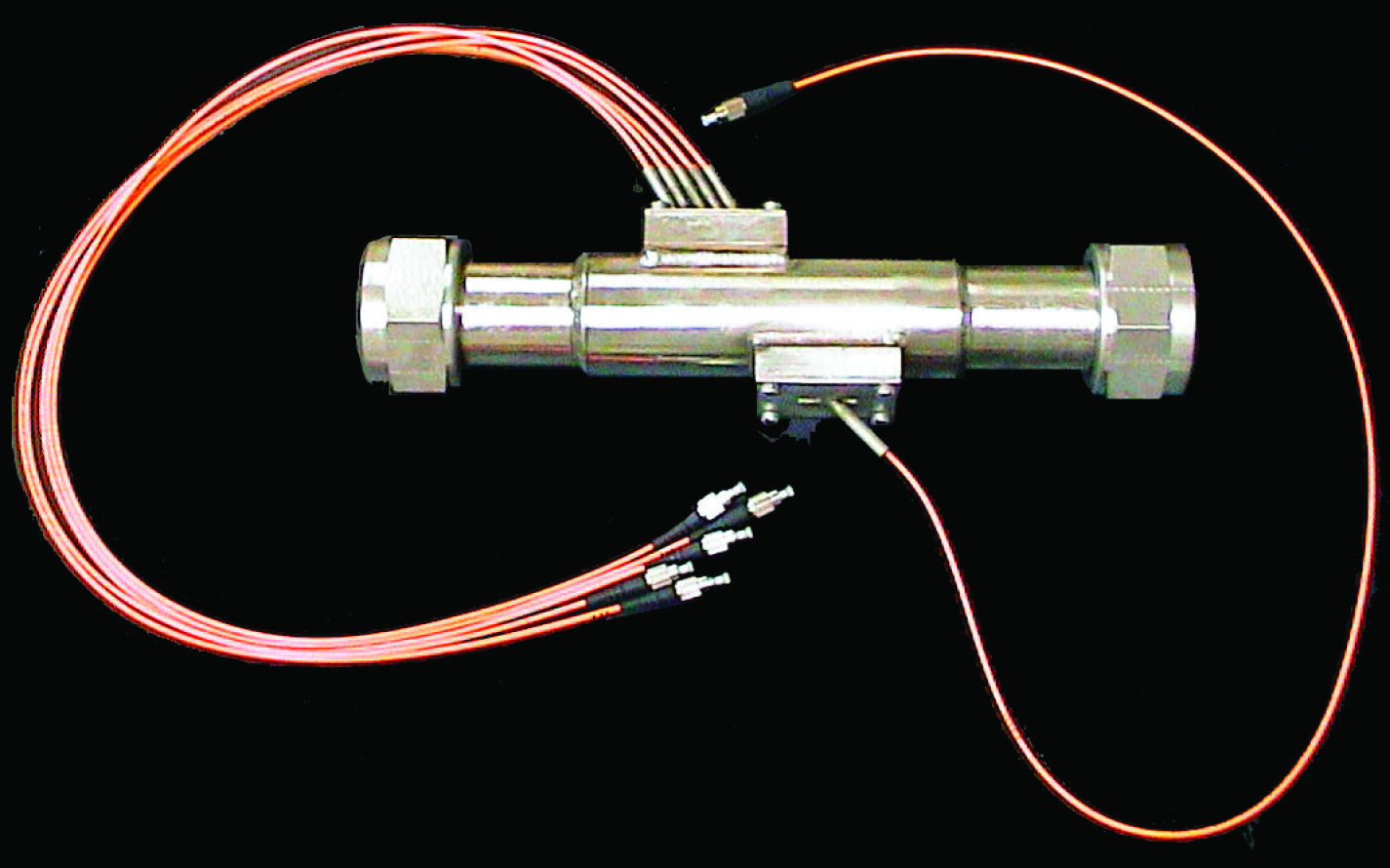Optical Mass Sensor for Multi-Phase Flows
Sensors
Optical Mass Sensor for Multi-Phase Flows (TOP8-91)
Noninvasive device provides both static and dynamic measures of void fraction in gas-vapor mixes
Overview
NASA's Marshall Space Flight Center is offering opportunities for its new fiber optic mass flow sensor system. Capable of measuring multi-phase flows in a pipe, the technology is minimally invasive, cost effective, retrofittable, and compact. MSFCs new technology combines high accuracy, intrinsically safe operation, and low-cost flow sensing for virtually any optically transparent medium, providing a superior product for measuring multi-phase flows.
The Technology
Unlike commercial turbine and Venturi-type sensors, which are flow intrusive and prone to high error rates, NASA's new flow sensor technology uses an optical technique to precisely measure the physical characteristics of a liquid flowing within a pipe. It generates a reading of the flows density, which provides a highly accurate mass flow measurement when combined with flow velocity data from a second optical sensor.
NASA's sensor technology provides both a void fraction measurement, which is a measurement of the instantaneous gas/liquid percentage of a static volume and a quality measurement, which is the fraction of flow that is vapor as part of a total mass flow. It also provides a direct measurement of the gas/liquid concentration within the flow, making it suited for real-time measurement of multi-phase flows.
The technology was originally developed to accurately determine the flow rates and tank levels of multi-phase cryogenic fuels used on various NASA vehicles including the Space Shuttle and in ground-based propulsion testing. It can also be used for a wide range of gas/liquid ratios, flows with complex cross sectional profiles, flows containing bubbles or quasi-solids, and essentially any liquid, gas, or multi-phase flow that can be optically characterized. Because it is insensitive to position, the new technology also has potential for use in zero-gravity tank level sensors.


Benefits
- Provides void fraction and quality values through real-time flow rate measurement
- Has no moving parts
- Keeps all sensor components external to flow path and insensitive to pipe material
- Is safe from electromagnetic interference and poses no radiation hazard
- Retrofits to existing piping systems from 0.5 to 12 in diameter
- Accommodates various flow schemes found within pipes including bubbles
- Is a potentially inexpensive sensor design
Applications
- Cryogenic liquid and fuel flow, handling, and storage measurements
- Oil and gas industry multi-phase flows
- Industrial, automotive, and aerospace multi-phase flows
- Powder spray coatings
- Food processing
- Chemical processing, handling, and storage
- Zero-gravity liquid tank level sensors
Technology Details
Sensors
TOP8-91
MFS-32031-1
-V. Korman. "Density and Cavitating Flow Results from a Full-Scale Optical Multiphase Cryogenic Flowmeter", (2007)
|
Tags:
|
Similar Results

Lightweight Fiber Optic Sensors for Real-Time Monitoring of Structural Health
How It Works
The FOSS technology employs efficient, real-time, data driven algorithms for interpreting strain data. The fiber Bragg grating sensors respond to strain due to stress or pressure on the substrate. The sensors feed these strain measurements into the systems algorithms to determine shape, stress, temperature, pressure, strength, and operational load in real time.
Why It Is Better
Conventional strain gauges are heavy, bulky, spaced at distant intervals (which leads to lower resolution imaging), and unable to provide real-time measurements. Armstrong's system is virtually weightless, and thousands of sensors can be placed at quarter-inch intervals along an optical fiber the size of a human hair. Because these sensors can be placed at such close intervals and in previously inaccessible regions (for example, within bolted joints, embedded in a composite structure), the high-resolution strain measurements are more precise than ever before. The fiber optic sensors are non-intrusive and easy to install—thousands of sensors can be installed in less time than conventional strain sensors and the system is capable of processing information at the unprecedented rate of 100 samples per second. This critical, real-time monitoring capability enables an immediate and informed response in the event of an emergency and allows for precise, controlled monitoring to help avoid such scenarios.
For more information about the full portfolio of FOSS technologies, see DRC-TOPS-37 or visit https://technology-afrc.ndc.nasa.gov/featurestory/fiber-optic-sensing

Beam Crossing Optical System
The conventional approaches for measuring focused laser differential interferometry either use a single-point mechanism that cannot calculate velocity or a system that creates non-parallel beams in the testing zone, causing differences in time to travel between beams throughout the testing zone, adding a level of uncertainty to velocity measurements.
For this technology, the inventors determined that the best approach is to use a method that ensures all laser beams propagating between the transmitter and receiver sides of the instrument are parallel to one another. This is done by crossing two orthogonally polarized beams at a Wollaston prism located just ahead of the field lens on the transmitter side of the FLDI. The polarization orientation of the two crossing beams must be at ±45 degrees to one another so that the Wollaston prism can further split the beams by a small angle (this gives the instrument its sensitivity to density fluctuations at each measurement point).
The use of wedge prisms (that comprise the beam crossing system) to redirect the split beams such that they cross the optical axis minimizes any distortion imparted to the beams. This is in contrast to the use of a spherical focusing lens to redirect the split beams, which can impart undesirable distortions to the beams and affect the focusing properties of the FLDI instrument between its transmitter and receiver sides.

Streamlined Liquid Level Sensing Using Fiber Optics
Armstrong has developed a robust fiber optic–based sensing technology that offers extraordinary accuracy in liquid level measurements. The sensing system uses fiber optic Bragg sensors located along a single fiber optic cable. These sensors actively discern between the liquid and gas states along a continuous fiber and can accurately pinpoint the liquid level.
How It Works
The technology uses a resistive heater wire bundled with the optical fiber. The heater is pulsed to induce a local temperature change along the fiber, and the fiber Bragg grating data is used to monitor the subsequent cooling of the fiber. The length of fiber in the liquid cools more rapidly than the portion of the fiber in the gas above the liquid. The measurement system accurately establishes the location of this transition to within 1/4-inch.
Why It Is Better
Armstrong's liquid level sensing technology was originally developed to measure cryogenic liquid levels in rockets, and it represents a significant advancement in the state of the art in this application. Conventional methods for measuring cryogenic liquid levels rely on cryogenic diodes strategically placed along a rod or rack. The diodes are mounted in pre-selected, relatively widely spaced positions along the length of a rod; this configuration provides limited, imprecise data. Furthermore, each diode on the rod has two wires associated with it, which means a single system may require a large number of wires, making installation, connectivity, and instrumentation cumbersome.
Armstrong's novel technology provides liquid measurements with much greater precision, achieving measurements at 1/4-inch intervals. Furthermore, the streamlined system uses just two wires, which greatly simplifies installation and instrumentation. Due to its extraordinary accuracy and ease of use, Armstrong's measurement system offers important advantages for a wide range of applications beyond cryogenic liquids.
In Addition
Researchers have developed a new manufacturing process that improves the ability of fiber optic sensing systems to measure temperature and liquid levels when operating in humid environments. The process involves eliminating moisture from the optical fiber coating, then completing the sensor assembly within humidity-controlled conditions. The resulting sensor hardware provides precise and accurate measurements even when operating in a humid environment.
For more information about the full portfolio of FOSS technologies, see DRC-TOPS-37 or visit https://technology-afrc.ndc.nasa.gov/featurestory/fiber-optic-sensing

Enhanced Fabrication Improves Temperature Sensing in Cryogenic Humid Environments
This technology was developed to improve Armstrong's multi-patented FOSS system, which has long been used to measure temperature and liquid levels in cryogenic environments. When the sensing system's fibers trapped humidity from the surrounding environment before their submersion into cryogenic liquids, the moisture adversely affected outputs. A new manufacturing process solves this problem, increasing reliability and accuracy not only of NASA's FOSS but also any fiber optic sensing system.
How It Works
Armstrong has developed a two-step process to assemble the sensors. First, the bare sensor fiber is inserted into an oven to expel all moisture from the fiber coating. Then, the moisture-free fiber is placed inside a humidity-controlled glove box to prevent it from absorbing any new moisture. While inside the glove box, the fiber is inserted into a loose barrier tubing that isolates the fiber yet is still thin enough to provide adequate thermal transfer. The tubing can be further purged with various gases while it is inside the glove box to provide additional moisture isolation.
This innovation is particularly useful for fiber optic systems that measure temperature and that identify any temperature stratifications within cryogenic liquids.
Why It Is Better
This process seals sensor fibers from environmental moisture, enabling fiber optic sensing systems to operate reliably in humid environments. The innovation eliminates erroneous readings that can occur due to moisture collection on the fiber sensors.
For more information about the full portfolio of FOSS technologies, see DRC-TOPS-37 or visit https://technology-afrc.ndc.nasa.gov/featurestory/fiber-optic-sensing

Adaptive Spatial Resolution Enables Focused Fiber Optic Sensing
This technology can be applied to most optical frequency domain reflectometry (OFDR) fiber optic strain sensing systems. It is particularly well suited to Armstrong's FOSS technology, which uses efficient algorithms to determine from strain data in real time a variety of critical parameters, including twist and other structural shape deformations, temperature, pressure, liquid level, and operational loads.
How It Works
This technology enables smart-sensing techniques that adjust parameters as needed in real time so that only the necessary amount of data is acquired—no more, no less.
Traditional signal processing in fiber optic strain sensing systems is based on fast Fourier transform (FFT), which has two key limitations. First, FFT requires having analysis sections that are equal in length along the whole fiber. Second, if high resolution is required along one portion of the fiber, FFT processes the whole fiber at that resolution. Armstrong's adaptive spatial resolution innovation makes it possible to efficiently break up the length of the fiber into analysis sections that vary in length. It also allows the user to measure data from only a portion of the fiber. If high resolution is required along one section of fiber, only that portion is processed at high resolution, and the rest of the fiber can be processed at the lower resolution.
Why It Is Better
To quantify this innovation's advantages, this new adaptive method requires only a small fraction of the calculations needed to provide additional resolution compared to FFT (i.e., thousands versus millions of additional calculations). This innovation provides faster signal processing and precision measurement only where it is needed, saving time and resources. The technology also lends itself well to long-term bandwidth-limited monitoring systems that experience few variations but could be vulnerable as anomalies occur.
More importantly, Armstrong's adaptive algorithm enhances safety, because it automatically adjusts the resolution of sensing based on real-time data. For example, when strain on a wing increases during flight, the software automatically increases the resolution on the strained part of the fiber. Similarly, as bridges and wind turbine blades undergo stress during big storms, this algorithm could automatically adjust the spatial resolution to collect more data and quickly identify potentially catastrophic failures.
This innovation greatly improves the flexibility of fiber optic strain sensing systems, which provide valuable time and cost savings to a range of applications.
For more information about the full portfolio of FOSS technologies, see DRC-TOPS-37 or visit https://technology-afrc.ndc.nasa.gov/featurestory/fiber-optic-sensing



